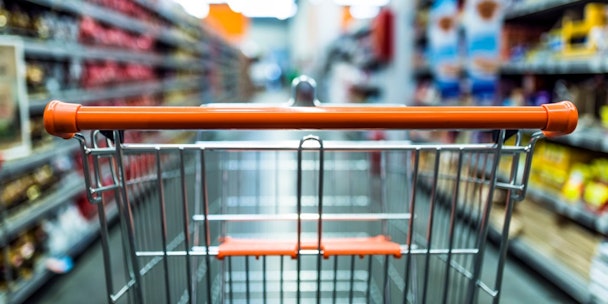UK store sales breakdown: what the results tell us about retail marketing for the year ahead
This week saw major retailers update on their festive performances. The Drum rounds-up the key numbers you need to know and considers what the results indicate for the year ahead in retail marketing.

Latest retail numbers you need to know
Despite the threat of the Omicron variant, staff shortages and supply chain issues, retailers managed to maintain the same Christmas grocery sales as the year before. According to Kantar, £11.5bn was spent at the tills while NielsenIQ found spend was up 1% on last year.
But before we go any further, Rob Sellers, head of retail at VCCP, has a warning: "We have to take all of the retail results with several chunky pinches of salt. The food retailers are all celebrating bumper sales, mainly because of so many economic and market factors that weighed in their favor. Premium (M&S), mid-market (Tesco) and discounters (Lidl) are claiming victory. But in reality, Omicron won Christmas for retailers.
"With cautionary guidance about socializing, without the firm restrictions we saw last year, consumers were wary of socializing in public spaces - but determined to celebrate the festive season among greater numbers of friends and family - where testing and sensible behaviour meant that full houses were back on the menu. In the weeks before Christmas, representatives from the hospitality and entertainment industries were on our news screens telling us about canceled parties, empty venues and collapsed revenues. And the millions and billions of pounds not spent in bars, restaurants and clubs ended up in the tills of retailers."
With that in mind, here's how the top UK retailers performed and what we know about the marketing strategies powering growth in 2022.
Tesco
-
2.7% rise in like-for-like sales in the UK and Ireland for the six weeks to 8 January compared to the same period last year.
-
Claims the highest share of the home grocery delivery market, taking an average 1.2m orders per week.
-
"Despite growing cost pressures and supply chain challenges in the industry, we continued to invest to protect availability, doubled down on our commitment to deliver great value and offered our strongest ever festive range," said chief exec Ken Murphy.
In the lead up to Christmas, Tesco launched its Retail Media offering, promising advertisers better insights and advice on best marketing practice by leveraging Clubcard and other store data and providing a variety of new ways to reach shoppers. Global data retail analyst Kunaal Shah said it saw success as a result of “competitive pricing through its Aldi Price Match strategy and its Clubcard-only discounts” so we could expect more marketing in 2022 to focus on its value proposition and encouraging people to sign up to Clubcard.
Marks and Spencer
-
Food sales soared 9.4% in the final 12 weeks of 2021 compared to same period in 2020. Compared to the past two years they were up 12.4%.
-
In a critical turnaround of its Clothing & Home division, M&S saw sales rise to £1.1bn, up 3.2%, meaning a second consecutive quarter of growth on the back of its pared back strategy.
-
“Trading over the Christmas period has been strong, demonstrating the continued improvements we’ve made to product and value,” said chief executive Steve Rowe.
Over the course of 2021, M&S was forced to shutter underperforming stores, but Laura Hoy, equity analyst at Hargreaves Lansdown, said the "pain of the pandemic sped up this restructuring process, and the results are very much being felt".
"It would appear Marks is nearing the end of this painful journey," she said. "It's not out of the woods yet, but it suggests the underlying business still has something to offer now the fat's been trimmed."
The food business "now takes now billing," according to Hoy, and we can expect that to be reflected in the marketing strategy this year.
Lidl
-
The British arm of the German discount supermarket chain said sales rose 2.6% in the four weeks ending 26 December.
-
Benefited to the tune of £21m from shoppers switching from other grocers.
-
Sales up 21% on a two-year basis leading to claims it's the fastest growing grocer in the UK.
-
However it refused to reveal data on whether the growth came from opening new stores or those already open for more than a year.
-
Its Christmas jumpers played "a starring role on and off screen" after featuring in its Christmas advert, becoming the fastest selling product in the 'Middle of Lidl' aisle.
Aldi
-
The UK's fifth-largest supermarket chain said sales in December rose by 0.4% compared to the previous year thanks to "half a million new shoppers in December".
-
Like Lidl, declined to confirm if the bumper performance was as a result of new store openings.
-
Highliting its commitment to marketing it highlighted the return of its character Kevin the Carrot in festive Christmas TV ads helped it win customers from rivals.
Sainsburys
-
Sales up for the six weeks to 8 January - when compared to the same pre-pandemic period in 2019/20 but down 2.9% down on 2020/21.
-
Online grocery sales fell 15% year-on-year.
-
Argos sales down more than 9% in the third quarter compared to the same period last year.
Sainsbury’s experimented with an Aldi Price Match promise on a limited number of products for one-week in the run up to Christmas. Sales of those lines - like turkeys - were up 23% year-on-year and 44% compared to Christmas 2019. Could we see more comparison tactics in its marketing this year?
It embarked on a ‘food-first’ strategy in 2020 which AJ Bell investment director Russ Mould said is “winning over some of the value-seeking shoppers” so continue to expect value-focused comms from the grocer.

